Wentao Hu
Efficient and Effective Model Extraction
Sep 24, 2024



Abstract:Model extraction aims to create a functionally similar copy from a machine learning as a service (MLaaS) API with minimal overhead, typically for illicit profit or as a precursor to further attacks, posing a significant threat to the MLaaS ecosystem. However, recent studies have shown that model extraction is highly inefficient, particularly when the target task distribution is unavailable. In such cases, even substantially increasing the attack budget fails to produce a sufficiently similar replica, reducing the adversary's motivation to pursue extraction attacks. In this paper, we revisit the elementary design choices throughout the extraction lifecycle. We propose an embarrassingly simple yet dramatically effective algorithm, Efficient and Effective Model Extraction (E3), focusing on both query preparation and training routine. E3 achieves superior generalization compared to state-of-the-art methods while minimizing computational costs. For instance, with only 0.005 times the query budget and less than 0.2 times the runtime, E3 outperforms classical generative model based data-free model extraction by an absolute accuracy improvement of over 50% on CIFAR-10. Our findings underscore the persistent threat posed by model extraction and suggest that it could serve as a valuable benchmarking algorithm for future security evaluations.
Reliable Model Watermarking: Defending Against Theft without Compromising on Evasion
Apr 21, 2024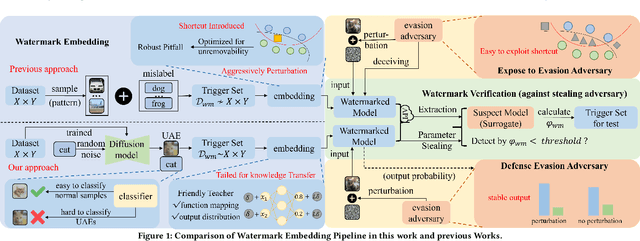
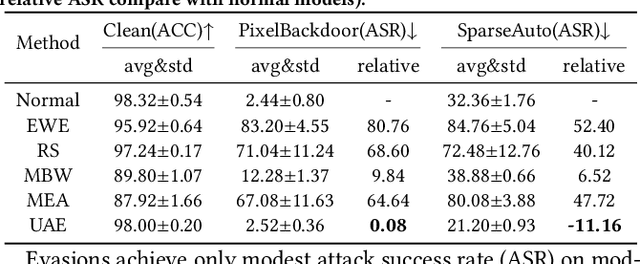
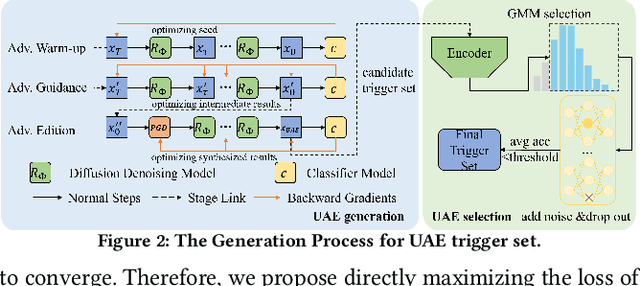

Abstract:With the rise of Machine Learning as a Service (MLaaS) platforms,safeguarding the intellectual property of deep learning models is becoming paramount. Among various protective measures, trigger set watermarking has emerged as a flexible and effective strategy for preventing unauthorized model distribution. However, this paper identifies an inherent flaw in the current paradigm of trigger set watermarking: evasion adversaries can readily exploit the shortcuts created by models memorizing watermark samples that deviate from the main task distribution, significantly impairing their generalization in adversarial settings. To counteract this, we leverage diffusion models to synthesize unrestricted adversarial examples as trigger sets. By learning the model to accurately recognize them, unique watermark behaviors are promoted through knowledge injection rather than error memorization, thus avoiding exploitable shortcuts. Furthermore, we uncover that the resistance of current trigger set watermarking against removal attacks primarily relies on significantly damaging the decision boundaries during embedding, intertwining unremovability with adverse impacts. By optimizing the knowledge transfer properties of protected models, our approach conveys watermark behaviors to extraction surrogates without aggressively decision boundary perturbation. Experimental results on CIFAR-10/100 and Imagenette datasets demonstrate the effectiveness of our method, showing not only improved robustness against evasion adversaries but also superior resistance to watermark removal attacks compared to state-of-the-art solutions.
SyncTalk: The Devil is in the Synchronization for Talking Head Synthesis
Nov 29, 2023Abstract:Achieving high synchronization in the synthesis of realistic, speech-driven talking head videos presents a significant challenge. Traditional Generative Adversarial Networks (GAN) struggle to maintain consistent facial identity, while Neural Radiance Fields (NeRF) methods, although they can address this issue, often produce mismatched lip movements, inadequate facial expressions, and unstable head poses. A lifelike talking head requires synchronized coordination of subject identity, lip movements, facial expressions, and head poses. The absence of these synchronizations is a fundamental flaw, leading to unrealistic and artificial outcomes. To address the critical issue of synchronization, identified as the "devil" in creating realistic talking heads, we introduce SyncTalk. This NeRF-based method effectively maintains subject identity, enhancing synchronization and realism in talking head synthesis. SyncTalk employs a Face-Sync Controller to align lip movements with speech and innovatively uses a 3D facial blendshape model to capture accurate facial expressions. Our Head-Sync Stabilizer optimizes head poses, achieving more natural head movements. The Portrait-Sync Generator restores hair details and blends the generated head with the torso for a seamless visual experience. Extensive experiments and user studies demonstrate that SyncTalk outperforms state-of-the-art methods in synchronization and realism. We recommend watching the supplementary video: https://ziqiaopeng.github.io/synctalk
AllTogether: Investigating the Efficacy of Spliced Prompt for Web Navigation using Large Language Models
Oct 31, 2023



Abstract:Large Language Models (LLMs) have emerged as promising agents for web navigation tasks, interpreting objectives and interacting with web pages. However, the efficiency of spliced prompts for such tasks remains underexplored. We introduces AllTogether, a standardized prompt template that enhances task context representation, thereby improving LLMs' performance in HTML-based web navigation. We evaluate the efficacy of this approach through prompt learning and instruction finetuning based on open-source Llama-2 and API-accessible GPT models. Our results reveal that models like GPT-4 outperform smaller models in web navigation tasks. Additionally, we find that the length of HTML snippet and history trajectory significantly influence performance, and prior step-by-step instructions prove less effective than real-time environmental feedback. Overall, we believe our work provides valuable insights for future research in LLM-driven web agents.
Towards Differential Privacy in Sequential Recommendation: A Noisy Graph Neural Network Approach
Sep 17, 2023Abstract:With increasing frequency of high-profile privacy breaches in various online platforms, users are becoming more concerned about their privacy. And recommender system is the core component of online platforms for providing personalized service, consequently, its privacy preservation has attracted great attention. As the gold standard of privacy protection, differential privacy has been widely adopted to preserve privacy in recommender systems. However, existing differentially private recommender systems only consider static and independent interactions, so they cannot apply to sequential recommendation where behaviors are dynamic and dependent. Meanwhile, little attention has been paid on the privacy risk of sensitive user features, most of them only protect user feedbacks. In this work, we propose a novel DIfferentially Private Sequential recommendation framework with a noisy Graph Neural Network approach (denoted as DIPSGNN) to address these limitations. To the best of our knowledge, we are the first to achieve differential privacy in sequential recommendation with dependent interactions. Specifically, in DIPSGNN, we first leverage piecewise mechanism to protect sensitive user features. Then, we innovatively add calibrated noise into aggregation step of graph neural network based on aggregation perturbation mechanism. And this noisy graph neural network can protect sequentially dependent interactions and capture user preferences simultaneously. Extensive experiments demonstrate the superiority of our method over state-of-the-art differentially private recommender systems in terms of better balance between privacy and accuracy.
Improve Deep Forest with Learnable Layerwise Augmentation Policy Schedule
Sep 16, 2023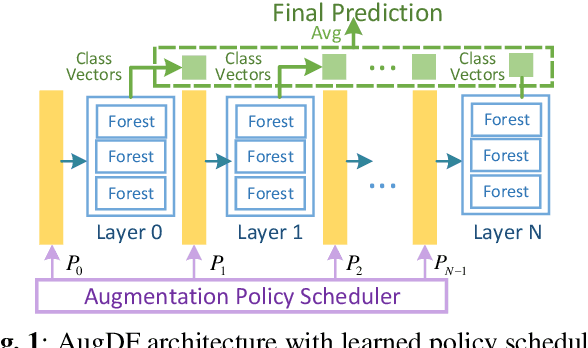
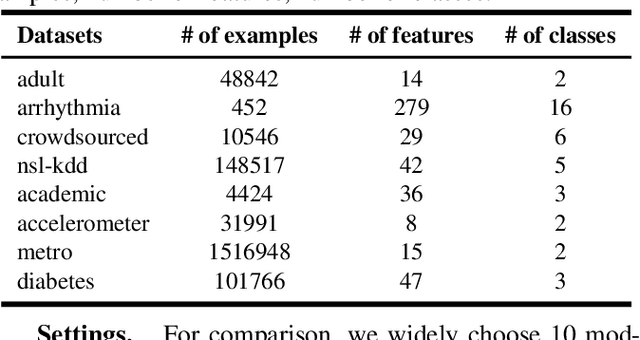

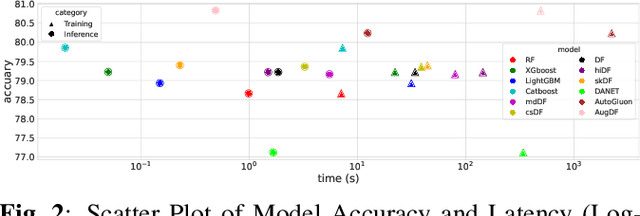
Abstract:As a modern ensemble technique, Deep Forest (DF) employs a cascading structure to construct deep models, providing stronger representational power compared to traditional decision forests. However, its greedy multi-layer learning procedure is prone to overfitting, limiting model effectiveness and generalizability. This paper presents an optimized Deep Forest, featuring learnable, layerwise data augmentation policy schedules. Specifically, We introduce the Cut Mix for Tabular data (CMT) augmentation technique to mitigate overfitting and develop a population-based search algorithm to tailor augmentation intensity for each layer. Additionally, we propose to incorporate outputs from intermediate layers into a checkpoint ensemble for more stable performance. Experimental results show that our method sets new state-of-the-art (SOTA) benchmarks in various tabular classification tasks, outperforming shallow tree ensembles, deep forests, deep neural network, and AutoML competitors. The learned policies also transfer effectively to Deep Forest variants, underscoring its potential for enhancing non-differentiable deep learning modules in tabular signal processing.
PlankAssembly: Robust 3D Reconstruction from Three Orthographic Views with Learnt Shape Programs
Aug 10, 2023



Abstract:In this paper, we develop a new method to automatically convert 2D line drawings from three orthographic views into 3D CAD models. Existing methods for this problem reconstruct 3D models by back-projecting the 2D observations into 3D space while maintaining explicit correspondence between the input and output. Such methods are sensitive to errors and noises in the input, thus often fail in practice where the input drawings created by human designers are imperfect. To overcome this difficulty, we leverage the attention mechanism in a Transformer-based sequence generation model to learn flexible mappings between the input and output. Further, we design shape programs which are suitable for generating the objects of interest to boost the reconstruction accuracy and facilitate CAD modeling applications. Experiments on a new benchmark dataset show that our method significantly outperforms existing ones when the inputs are noisy or incomplete.
Meta-DM: Applications of Diffusion Models on Few-Shot Learning
May 14, 2023



Abstract:In the field of few-shot learning (FSL), extensive research has focused on improving network structures and training strategies. However, the role of data processing modules has not been fully explored. Therefore, in this paper, we propose Meta-DM, a generalized data processing module for FSL problems based on diffusion models. Meta-DM is a simple yet effective module that can be easily integrated with existing FSL methods, leading to significant performance improvements in both supervised and unsupervised settings. We provide a theoretical analysis of Meta-DM and evaluate its performance on several algorithms. Our experiments show that combining Meta-DM with certain methods achieves state-of-the-art results.
Decentralized Matrix Factorization with Heterogeneous Differential Privacy
Dec 01, 2022Abstract:Conventional matrix factorization relies on centralized collection of users' data for recommendation, which might introduce an increased risk of privacy leakage especially when the recommender is untrusted. Existing differentially private matrix factorization methods either assume the recommender is trusted, or can only provide a uniform level of privacy protection for all users and items with untrusted recommender. In this paper, we propose a novel Heterogeneous Differentially Private Matrix Factorization algorithm (denoted as HDPMF) for untrusted recommender. To the best of our knowledge, we are the first to achieve heterogeneous differential privacy for decentralized matrix factorization in untrusted recommender scenario. Specifically, our framework uses modified stretching mechanism with an innovative rescaling scheme to achieve better trade off between privacy and accuracy. Meanwhile, by allocating privacy budget properly, we can capture homogeneous privacy preference within a user/item but heterogeneous privacy preference across different users/items. Theoretical analysis confirms that HDPMF renders rigorous privacy guarantee, and exhaustive experiments demonstrate its superiority especially in strong privacy guarantee, high dimension model and sparse dataset scenario.
 Add to Chrome
Add to Chrome Add to Firefox
Add to Firefox Add to Edge
Add to Edge